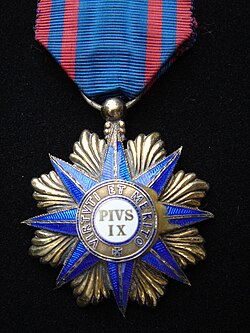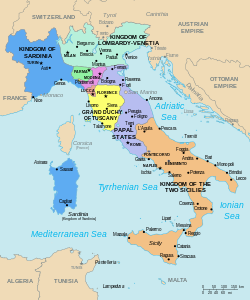| Order of Pope Pius IX Ordine di Pio IX (Italian) | |
|---|---|
 Knight's cross of the Order of Pius IX | |
| Awarded by the | |
| Type | Papal order of knighthood |
| Established | 17 June 1847 [1] |
| Religious affiliation | Catholic |
| Motto | |
| Status | Currently constituted |
| First head | Pope Pius IV |
| Sovereign | Pope Leo XIV |
| Classes |
|
| Precedence | |
| Next (higher) | Order of the Golden Spur |
| Next (lower) | Order of St. Gregory the Great |
| Ribbon bar of the order | |
The Order of Pope Pius IX (Italian : Ordine di Pio IX), also referred as the Pian Order (Italian : Ordine Piano, pronounced [piˈaːno] ), is a papal order of knighthood originally founded by Pope Pius IV in 1560. It is the highest honor currently conferred by the Holy See (two higher honors, the Supreme Order of Christ and the Order of the Golden Spur, are dormant). The awarding of the order fell into disuse and was re-instituted by Pope Pius IX as a continuation on 17 June 1847. [1]
Contents
- History of the Order
- Order of Classes
- Insignia and uniform
- Notable members
- Royal houses and nobility
- Heads of State and Politicians
- Diplomats to the Holy See
- Other notable members
- See also
- References
- External links
The highest rank awarded by the Pope is the Collar of the Order, usually to Catholic heads of state on the occasion of official visits to the Holy See. The Grand Cross is the highest Papal award given to lay men and women, ordinarily given to resident Ambassadors accredited to the Holy See after two years in post and rarely to exceptional Catholics in the wider world for particular services, mainly in the international field and for outstanding deeds for Church and society.
The rank of Knight is almost never awarded, and when it happens, it is given in recognition of high-profile services rendered to the Holy See or directly to the person of the Pontiff, by Catholic faithful of distinguished status, almost always belonging to ancient European noble families.
The other two ranks (Commander and Commander with Star) are granted sparingly to lay Catholics, usually in diplomatic roles, for extraordinary merit or deeds for the Church and society. The order is awarded to Catholics and, on occasion and only for diplomatic reasons, to non-Catholics and non-Christians as well.












